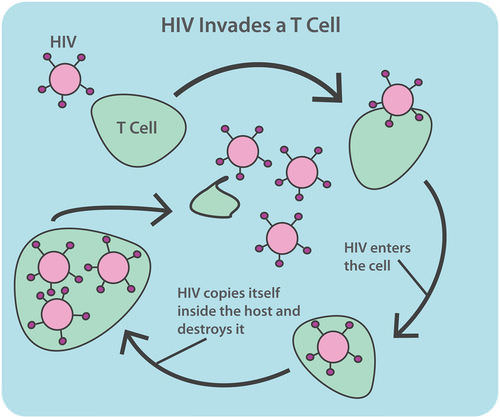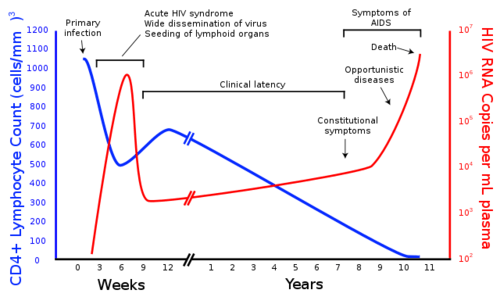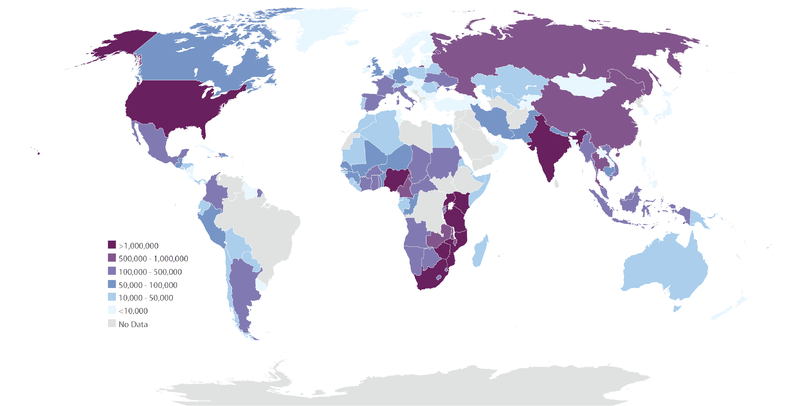艾滋病毒/艾滋病 -- -- 先进
章节大纲
-
How long can a person live with ?
::一个人能活多久?Years ago, a diagnosis of an HIV infection was a death sentence. Not today. With the proper medical treatment, an individual can live well over 10 or 20 or more productive years with an AIDS diagnosis. One of the most famous individuals with HIV is Earvin "Magic" Johnson, a retired professional basketball player. He was diagnosed in 1991. Over 20 years later, he is still doing well.
::几年前,对艾滋病毒感染的诊断是死刑判决,而不是今天。通过适当的医疗治疗,一个人在艾滋病诊断下可以活10年或20年以上或更多年。最有名的艾滋病毒感染者之一是退休职业篮球运动员Earvin“Magic”Johnson。他于1991年被诊断为1991年。20年后,他仍然表现良好。HIV and AIDS
::艾滋病毒/艾滋病HIV, or human immunodeficiency virus , is the that causes AIDS. AIDS stands for acquired immune deficiency syndrome. It is a late stage in the progression of an HIV infection.
::艾滋病毒或人体免疫机能丧失病毒是造成艾滋病的原因,艾滋病是后天免疫机能丧失综合症,是艾滋病毒感染的后期阶段。This is a representation of HIV. HIV is a virus that attacks cells of the immune system. Notice the various structures on the viral surface. HIV Transmission
::艾滋病毒传播HIV is transmitted, or spread, through direct contact of either mucous membranes or body fluids containing HIV. Body fluids that can contain HIV include , semen , vaginal fluid, preseminal fluid, and breast milk. Transmission of the virus can occur through sexual contact or use of contaminated hypodermic needles . HIV can also be transmitted through a mother’s blood to her baby during late or birth or through breast milk after birth. In the past, HIV was transmitted through blood transfusions. Because donated blood is now screened for HIV, the virus is no longer transmitted this way.
::艾滋病毒是通过粘膜或含有艾滋病毒的体液直接接触传播或传播的。 可能含有艾滋病毒的体液包括精液、阴道液、前期液和母乳。 病毒的传播可以通过性接触或使用被污染的皮下针头进行。 艾滋病毒也可以通过母亲的血液在晚产期或产后或通过产后母乳传播给婴儿。过去,艾滋病毒是通过输血传播的。由于捐赠的血液现在被检测为艾滋病毒,病毒不再以这种方式传播。HIV may be transmitted in all of the ways shown here. Based on how HIV is transmitted, what can people do to protect themselves from becoming infected? What choices can they make to prevent infection? HIV and the Immune System
::艾滋病毒和免疫系统HIV destroys helper T cells . Recall that helper T cells are needed for normal humoral and cell-mediated . When HIV enters a person’s bloodstream, on the coat of the virus allow it to fuse with the host’s helper T cells. The virus injects its own into the host’s helper T cells and uses the T cells’ “machinery” to make copies of itself. The copies of the virus bud off from the host’s , destroying the cells in the process. Copies of the virus go on to infect other helper T cells throughout the body.
::艾滋病毒摧毁了T类帮手细胞。 提醒大家注意,正常的幽默和细胞介质需要T类帮手细胞。 当HIV进入一个人的血液时,在病毒的外衣上,它就能与宿主的T类帮手细胞结合。 病毒将其自身注入宿主的T类帮手细胞,并使用T类“机器”复制自己。 病毒从宿主那里取出,在过程中摧毁了细胞。 病毒的复制件会感染整个身体的其他帮手T类细胞。This diagram shows how HIV infects and destroys helper T cells. During the first several weeks after HIV infection, the immune system tries to fight off the virus. As shown in Figure , the initial immune response temporarily reduces the number of virus copies in the blood. However, the immune system is unable to completely destroy the virus, and it continues to multiply in the . How is HIV able to evade the immune system? There are at least two ways:
::如图所示,最初的免疫反应暂时减少了血液中的病毒复制数。然而,免疫系统无法完全摧毁病毒,并且继续增加。艾滋病毒如何能逃脱免疫系统?至少有两种方法:-
The virus undergoes frequent
that keep changing the
antigens
on its coat. This prevents antigen-specific
lymphocytes
from developing that could destroy the virus.
::病毒经常变换外衣上的抗原,防止特定抗原淋巴细胞发育,从而摧毁病毒。 -
The virus uses the host’s
to form is own coat. This covers up viral antigens, so they cannot be detected by the host’s immune system.
::病毒使用宿主的外衣来形成自己的外衣。它遮盖了病毒抗原,因此无法被宿主的免疫系统检测到。
Average numbers of helper T cells and HIV copies in untreated HIV infections. Over the next several years, helper T cells continuously decline in the blood, while copies of the virus keep increasing. As the number of helper T cells declines, so does the ability of the immune system to make an immune response. The HIV-infected person starts showing symptoms of a failing immune system, such as frequent infections.
::在未来几年里,帮助T细胞的血液持续下降,而病毒的复制量却在不断增加。 随着帮助T细胞数量的减少,免疫系统做出免疫反应的能力也随之下降。 艾滋病毒感染者开始表现出免疫系统衰竭的症状,比如频繁感染。Treatment with antiviral medications can slow down the increase in virus copies, although they do not eliminate the virus altogether. The medications usually lengthen the time between infection with HIV and the of symptoms. However, there is currently no cure for HIV infection or AIDS and no vaccine to prevent infection, although this is a field of intense study by biomedical scientists.
::抗病毒药物的治疗可以减缓病毒复本的增加速度,尽管它们并没有完全消灭病毒。 药物通常会延长艾滋病毒感染和症状之间的时间。 但是,目前没有治疗艾滋病毒感染或艾滋病的疗法,也没有预防感染的疫苗,尽管生物医学科学家对此进行了深入的研究。AIDS
::艾滋病艾滋病AIDS is not a single disease, but rather it is a collection of symptoms and diseases. It is the result of years of damage to the immune system by HIV. AIDS is diagnosed when helper T cells fall to a very low level and the infected person develops one or more opportunistic diseases .
::艾滋病并不是一种单一的疾病,而是一系列的症状和疾病,是多年来艾滋病毒对免疫系统造成伤害的结果,如果帮助T细胞降到非常低的水平,感染者患上一种或多种机会性疾病,就会诊断出艾滋病。Opportunistic diseases are infections and tumors that are rare in people with a healthy immune system, but common in immunodeficient people. Opportunistic diseases include pneumocystis pneumonia and Kaposi’s sarcoma, a type of . The diseases are called opportunistic because they take advantage of the “opportunity” to infect a person with a damaged immune system that can’t fight back. Opportunistic diseases are often the direct cause of death of people with AIDS.
::机会性疾病是感染和肿瘤,在拥有健康的免疫系统的人中是罕见的,但在免疫不良的人中很常见。 机会性疾病包括肺炎和卡波西的沙科马(一种类型 ) 。 这些疾病被称为机会性疾病,因为它们利用“机会”来感染一个免疫系统受损、无法反击的人。 机会性疾病往往是艾滋病患者死亡的直接原因。AIDS was first identified in 1981. Since then, it has killed more than 25 million people worldwide, many of them children. The hardest hit region is sub-Saharan Africa, where antiviral medications are least available. The worldwide economic toll of AIDS is also enormous.
::1981年首次发现艾滋病,自那时以来,艾滋病已使全世界2 500多万人丧生,其中许多是儿童,受影响最严重的地区是撒哈拉以南非洲,那里的抗病毒药物供应最少,艾滋病在全世界造成的经济损失也是巨大的。This map shows the number of people in different countries with HIV infections and AIDS in 2008. The rate of spread of the infection is higher in Africa than in the U.S., yet the U.S. has a relatively large number of people with HIV infections and AIDS. Why might there be more survivors with HIV infections and AIDS in the U.S. than in Africa? HIV Research: Beyond the Vaccine
::艾滋病毒研究:疫苗之后Over the past 15 years, the number of people who die of AIDS each year in the United States has dropped by 70 percent. But AIDS remains a serious public health crisis among low-income African-Americans, particularly women. And in sub-Saharan Africa, the virus killed more than 1.6 million people in 2007 alone. Innovative research approaches could lead to new treatments and possibly a cure for AIDS. HIV/AIDS has been described as a disease of poverty. Individuals with poor access to health care are less likely to see a doctor early on in their HIV infection, and thus they may be more likely to transmit the infection. HIV is now the leading cause of death for African American women between 24 and 35 years old.
::在过去15年中,美国每年死于艾滋病的人数下降了70%,但艾滋病仍然是低收入非裔美国人,特别是妇女的严重公共卫生危机。仅在撒哈拉以南非洲,2007年就有超过160万人死于艾滋病。创新研究方法可以导致新的治疗,并可能治愈艾滋病。艾滋病毒/艾滋病被描述为一种贫困疾病。获得医疗保健机会差的个人在感染艾滋病毒的早期就不太可能看医生,因此他们可能更容易传染。艾滋病毒现在是24至35岁非裔美国妇女死亡的主要原因。For patients who have access to drugs , infection with the virus has ceased to be a death sentence. In 1995, combinations of drugs called highly active anti-retroviral therapy (HAART) were developed. For some patients, drugs can reduce the amount of virus to undetectable levels. But some amount of virus always hides in the body's immune cells and attacks again if the patient stops taking his or her medication. Researchers are working on developing a drug to wipe out this hidden virus, which could mean the end of AIDS.
::对于那些能够获得药物的病人来说,病毒感染不再是死刑。 1995年,研制了称为高度活跃抗逆转录病毒疗法(HAART)的药物组合。对于一些病人来说,药物可以将病毒数量降低到无法检测的水平。 但是,如果病人停止服用药物,某些病毒总是隐藏在身体的免疫细胞中,并且再次袭击。研究人员正在研制一种药物来消灭这种隐藏的病毒,这可能意味着艾滋病的终结。Summary
::摘要-
HIV is transmitted, or spread, through direct contact of either mucous membranes or body fluids containing HIV.
::艾滋病毒通过粘膜直接接触或含有艾滋病毒的体液传播或传播。 -
When HIV enters a person’s bloodstream, proteins on the coat of the virus allow it to fuse with the host’s helper T cells and make copies of itself before destroying the cell.
::当艾滋病毒进入一个人的血液时,病毒外衣上的蛋白质允许它与宿主的帮助T细胞结合,并在摧毁细胞之前自行复制。 -
HIV evades the immune system by frequent mutations and by using the host's cell membranes to form its own coat.
::艾滋病毒经常发生突变,并利用宿主的细胞膜形成自己的大衣,从而逃避免疫系统。 -
AIDS is not a single disease, but rather it is a collection of symptoms and diseases that result from years of damage to the immune system by HIV.
::艾滋病并不是一种单一的疾病,而是由于艾滋病毒对免疫系统多年的损害而造成的一系列症状和疾病。
Review
::回顾-
How is HIV commonly transmitted?
::艾滋病毒是如何普遍传播的? -
How does HIV replicate?
::艾滋病毒是如何复制的? -
What allows HIV to evade the immune system?
::是什么允许艾滋病毒逃避免疫系统? -
Why is HIV described as a disease of poverty?
::为什么艾滋病毒被描述为贫穷疾病?
-
The virus undergoes frequent
that keep changing the
antigens
on its coat. This prevents antigen-specific
lymphocytes
from developing that could destroy the virus.





